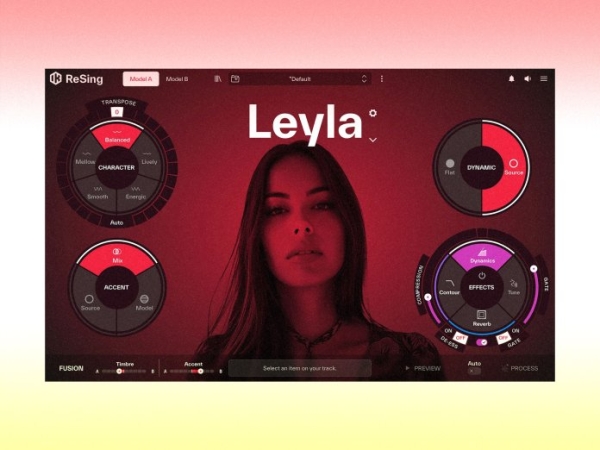IK Multimedia Announces ReSing — an “Ethically Sourced” AI Voice-Modelling Tool
AI voice modelling has been one of 2024–25’s most heated conversations in music tech: transformative for producers, unnerving for some artists. Into that debate steps IK Multimedia with ReSing, a desktop plug-in and standalone app that the company bills as an ethical, artist-friendly take on voice modelling — trained on “ethically sourced, original datasets” and designed to run on your computer rather than in the cloud.
What is ReSing?
ReSing promises to turn scratch or modestly recorded vocals into “ultra-natural” performances by swapping the timbre and phonetic characteristics of a track with those of a high-quality AI voice model. It’s presented as a professional tool for music producers who want studio-ready vocals without re-recording, and as a way for creators to model their own voices for personal use or licensing. The engine works as both a DAW plugin (ARA-compatible) and a standalone app, letting you edit dynamics, EQ, reverb, and pitch from inside your production environment.
The “Ethically Sourced” Claim — what does it mean?
IK has put the ethics label front and centre. According to the company, ReSing’s voice models are built from original datasets where vocal artists have “signed clear and transparent agreements” that ensure contributors are licensed, credited, and protected — language designed to address the biggest legal and moral critiques of AI audio (unauthorised use, hidden datasets, and murky royalty situations). IK says this approach removes the “gray areas” often associated with AI in music.
That’s an important distinction: rather than training on scraped or ambiguous datasets, IK claims each model in ReSing is the result of explicit artist consent and clear licensing. The company also plans a “Sessions” system where partner voice models will be available for short-term hire, so users can license a voice for a project rather than relying on unvetted samples.
Desktop processing vs cloud services
One of ReSing’s selling points is that the heavy lifting happens locally — on your own machine — not on external servers. IK argues this gives users more control (and privacy), avoids upload queues, and reduces reliance on cloud subscriptions. For producers and studios that prioritize data control or work with confidential material, local processing is a meaningful advantage. It also sidesteps certain legal and jurisdictional complexities that come with sending artist stems to third-party servers.
Editions, pricing, and availability
IK has positioned ReSing with tiered access. A free edition provides a small set of voices and user-model slots; higher-tier editions unlock more voices, instruments, and the ability to save and manage additional user models. The product is available for pre-order now and is scheduled for a late-October 2025 launch, with introductory pricing on the paid tiers. There will also be the option to rent “Session” voices on a monthly terms. (See IK’s product pages and early press for the precise tier breakdowns and pre-order offers.)
-
Practicality for creators. For independent producers, session singers, and solo artists, ReSing could cut the time and cost of re-tracking vocals while offering stylistic flexibility (genre tweaks, blended timbres, accent changes). Doing this locally makes it accessible in typical studio setups.
-
Artist control & new revenue paths. If IK’s licensing claims hold up, a transparent system where vocalists opt in and can be compensated or credited could become a template for ethical AI in music — an alternative to models trained on unconsented material. The Sessions rental model also suggests new revenue streams for vocalists who want to license their timbres.
-
Creative possibilities. Beyond straight replacement, ReSing’s ability to blend characteristics or apply instrument-style modelling (guitar→sax-like transformations were demoed) opens new sound design avenues that might inspire fresh musical directions.
Concerns and caveats
No single product will erase the broader ethical and legal debates around AI audio. Even with signed agreements, questions remain about:
-
Scope of Consent: How Detailed Are the Contracts? Do they permit unlimited commercial use, or are there limits? Who controls moral rights and future uses? IK’s statements sound promising, but the contracts’ specifics matter.
-
Perceived authenticity: Some producers and listeners still prefer the subtle imperfections of human performance. Forum chatter and early reactions have mixed tones — curiosity and praise for the tech, but also skepticism about realism and taste. Public discussion online already shows a range of responses from excitement to unease.
-
Market impacts: If it becomes cheap and easy to generate realistic vocals, session work and vocal branding could shift. That has both democratizing and disruptive economic effects — potential new income for some artists, and replacement pressures for others.
Community reaction so far
Early write-ups in the trade press are largely intrigued, describing ReSing as a “breakthrough” with impressive demo examples (and noting the ethics framing). At the same time, online forums show the usual mixture of hype and cynicism — some users question whether AI vocals genuinely compete with the nuance of real singers. In contrast, others point to creative uses beyond mimicry. It’s a classic technology debut: the tool is powerful, but how the industry chooses to use it will define whether the impact is net positive.
Bottom line
IK Multimedia’s ReSing is worth watching. It packages advanced voice-modelling tech with two potentially influential choices: local processing (privacy/control) and a stated commitment to ethically sourced datasets (artist consent and clear licensing). If IK’s promises about contracts, compensation, and transparency are upheld in practice, ReSing could be an early example of how AI tools and artist rights can be balanced. But the devil is in the details — contract terms, the breadth of permitted uses, and how the industry responds will determine whether “ethical AI” becomes a genuine standard or a marketing line.
If you produce vocals, manage artists, or care about the future of recorded performance, give the demos a listen when they’re available and read the licensing terms carefully before integrating AI-modelled voices into releases. The tech is moving fast; the rules and norms will follow.
Sources: IK Multimedia product/announcement pages; coverage in MusicRadar, MusicTech, Sound On Sound and early community discussion threads



